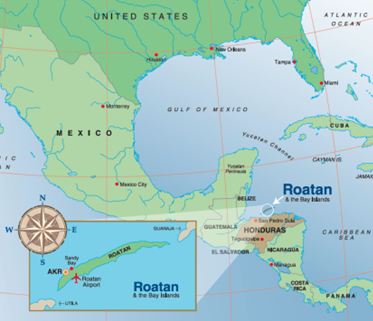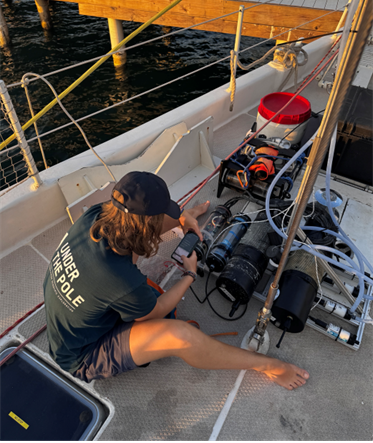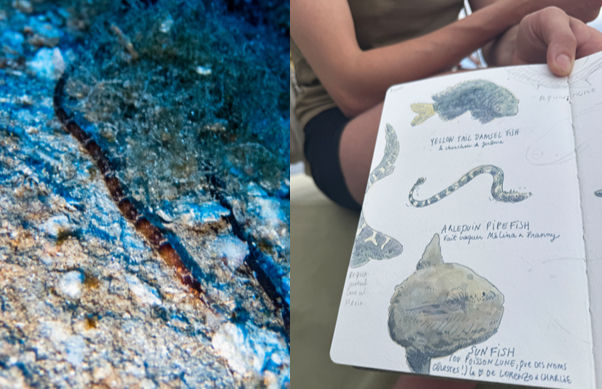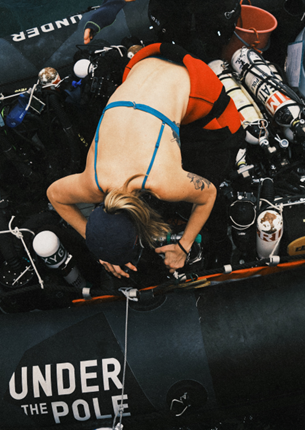STUDYING MARINE ANIMAL FORESTS IN THE MESOPHOTIC ZONE with UNDER THE POLE | EXPEDITION RE-CAP
- scuba_franny

- May 11
- 7 min read
Updated: Nov 17

APRIL 2025 | ROATAN, HONDURAS

ALL ABOARD THE WHY
For over 15 years, Under the Pole has been documenting unique marine ecosystems from the tropics to the poles and advocating for their protection. The uber-dedicated explorer-conservationist husband and wife duo, Emmanuelle & Ghislain Bardout, transformed their passion into profession, and they lead an impressive multi-disciplinary team of divers, researchers, artists, and technicians aboard their research sailboat, the WHY. For the past 3 months, the WHY has been located in Roatan, Honduras.

Under the Pole (UTP) is an underwater exploration program with 3 major missions:1) scientific research, 2) awareness, and 3) innovation. UTP is one of the most dedicated groups to protecting the oceans and dozens of their expeditions have already brought together 150 crew members and 180 partner companies and research institutes. In a unique collaboration with the French National Centre for Scientific Research (CNRS), UTP is currently on expedition in Roatan for their DEEPLIFE 2021-2030 research program. This research aims to deepen the scientific understanding of marine animal forests down to a depth of 200 meters for conservation purposes around the world.

During the DEEPLIFE expedition in April 2025, Francheska ‘Scuba Franny’ Krysiak joined the team for a week in Roatan, Honduras. With the leadership of scientific co-director Lorenzo Bramanti from the CNRS, divers conducted research activities in a mesophotic marine animal forest at 70 meters. Like many Caribbean marine parks, current protection in Roatan ends at 60 meters. The data collected during this expedition will help inform ongoing and future conservation endeavors expand protections to the mesophotic and protect the entirety of the reef.
Mesophotic means “middle light”. Mesophotic coral ecosystems (MCEs) exist from 30- 150 meters and are dominated by corals that have adapted to low-light conditions. They are extensions of shallow coral reefs, with some overlap of species (e.g., fishes, sponges, macroalgae), yet distinct assemblages. MCEs are essential
habitats for reef-associated species for feeding, reproduction, and growth. Despite being 80% of potential coral reef habitat worldwide, they remain threatened and under-studied.

DIVING DEEP INTO THE FOREST
THE RATIONALE FOR DIVING TO THE MESOPHOTIC ZONE
Coral reefs support a large contribution to biodiversity despite covering only ~1% of the space in the global ocean; however, their ability to support the well-being of 500 million people who currently rely upon them for food (e.g., fisheries), livelihoods (e.g., tourism), and regulative processes (e.g., storm protection) is being diminished. Globally, the current understanding of coral reefs is heavily biased towards information collected in shallow reefs (0-30 meters), and limited information exists about the diversity and ecological processes across the entire photic zone (surface to ~200m).
Because these deeper ecosystems are subject to many of the impacts occurring in shallower waters (e.g., sedimentation, pollution, invasive species), a greater understanding of the mesophotic zone is essential. To address this knowledge gap, scientific researchers are diving deeper to conduct research activities in marine animal forests. Their findings are essential to strengthen conservation strategies and inform initiatives to protect the full range of coral reef ecosystems – and the many benefits they provide to people and the planet.
Marine Animal Forests are ecosystems dominated by sessile suspension feeders like corals, sponges, & bivalves. They are found in all oceans, from shallow to deep waters. MAFs create 3D structure that provides essential habitat for marine species (e.g., protection, food, nursery). Despite their important role in hydrodynamic and biogeochemical cycles, human impacts have led to loss of biomass and biodiversity in MAFs worldwide.
UNDERWATER RESEARCH
ENABLED BY CLOSED CIRCUIT REBREATHERS

To support the study of mesophotic MAFs, technical divers carried out scientific activities underwater while using rebreathers, which are advanced diving devices that enable the divers to work at depths beyond typical recreational diving levels. Using trimix (a blend of helium-nitrogen-oxygen), divers were able to work at a depth of 70 meters for approximately 40 minutes to deploy monitoring tools, collect samples, survey reef fish populations, and document the ecosystem with photo/video.

Divers collected samples of corals, invertebrates, and fish, which is important as many mesophotic species remain unknown. The collection of gorgonians and their epifauna will provide more information about the diversity and functions of MAF communities. Divers also deployed sediment traps at several locations in the study site and retrieved the contents for analysis. My role during the dives was to survey mesophotic coral reef fish communities. I used a 30-meter measuring tape and a waterproof notebook to record the abundance of mesophotic coral reef fish along each transect. In addition to identifying species from memory, I also documented them through photo/videography.

Project DEEPLIFE: 2021-2030
With the aim of putting ocean exploration at the service of science, Under the Pole and the French National Centre for Scientific Research (Centre national de la recherche scientifique - CNRS) have launched DEEPLIFE: 2021-2030, a research program with many international scientific partners to deepen the scientific knowledge of marine animal forests. DEEPLIFE has been recognized by the United Nations and it is an official "Decade of the Ocean" project. It aims to promote synergies, partnerships, public awareness, education, and an effective science-policy interface, with the ultimate goal to enable joint and enhanced action for the ocean. This project links to SDG 14 - Aquatic life - one concerted action at all levels is necessary to preserve the health and integrity of the ocean, its ecosystems, and its contributions to our society and all living things. One of its significant measures is to deepen scientific knowledge, strengthen research resources and transfer marine techniques (SDG 14.8).
DATA FROM THE DEPTHS

THE TOOLS USED TO STUDY THE MESOPHOTIC
The metabolism of mesophotic marine animal forests is driven by net community production (NCP) and calcification (NCC), which influence air-sea CO2 exchange and the availability of carbon and calcium carbonate for sediment burial. The COMmunity METabolism (COMET) tool measures NCP and NCC by integrating information from sensors that monitor pH, oxygen, photosynthetic active radiation (PAR), and current velocities using an Acoustic Doppler Current Profiler (ADCP). The COMET combines chemical and physical data to estimate benthic fluxes of dissolved substances. More broadly, the COMET enables high-resolution, long-term monitoring of benthic metabolism, offering insights into the functions of MAFs, their role in ocean biogeochemistry, and their resilience to environmental changes.

In addition to the COMET, sediment traps were used to collect sinking particles to measure the sedimentation occurring inside and outside of the MAF. The analyzed contents can provide information about conditions within (and outside) the MAF as well as ecosystem health (e.g., coral stress) and reef degradation (e.g., runoff, coastal development). Within these sediment traps, two small coral reef fish (Apogon sp.) were also collected. These coral reef fish will be sent off for genome sequencing along with the samples of gorgonians from various depths (pictured).

Genome sequencing of corals and coral reef fishes has become a powerful tool in marine biology, conservation, and evolutionary research. Collections of genomic samples are crucial for tracking population connectivity, detecting hybridization, and predicting resilience to environmental change. This type of data is helping to inform conservation strategies (e.g., by identifying evolutionarily significant units (ESUs) for targeted conservation). These genomic insights will enhance our understanding of reef ecosystem dynamics and support evidence-based conservation efforts.
AN ARTIST’S PERSPECTIVE

TURNING SCIENCE INTO STORYTELLING
One of the most unique components of this expedition was the amazing diversity of perspectives onboard – I loved seeing marine conservation through the eyes of artists! Elsa Guillaume captured the daily life of the crew through her amazing watercolor storybook (pictured: right). When I was asked about my favorite fish, I answered ‘Pipefish’ – and I serendipitously photographed one during a transect the very next day (left)!

REFLECTIONS FROM ROATAN
WITNESSING CHANGE, EMBRACING PURPOSE
Reflecting on this expedition, I’m grateful for another opportunity to dive in Roatan and to develop a new collaboration with Under the Pole team. Since I began diving in the Roatan Marine Park in 2017, I’ve witnessed firsthand the beauty of these reef systems—and, heartbreakingly, their ongoing decline. The vast majority of my 4,000 dives have taken place in Roatan, where I also completed my training to become a dive professional and a technical rebreather diver. The degradation I’ve observed over the past 8 years has been intense, especially since 2020 when Stony Coral Tissue Loss Disease began contributing to the loss of ~22 prominent reef-building coral species. These changes have only deepened my commitment to marine conservation and confirmed the role that science divers have in documenting and protecting these fragile environments.

This expedition has not only expanded my technical skills and scientific knowledge but also reaffirmed my purpose. Volunteering alongside the UTP team—an inspiring group of experienced divers, scientists, and explorers—was both humbling and energizing. Their depth of experience, curiosity, and commitment to the ocean brings together innovation, exploration, and conservation in powerful ways.
As I look ahead, I plan to continue sharing my skills, pursuing every opportunity to contribute to the research and restoration of mesophotic coral ecosystems, and supporting collaborative projects that bridge local knowledge with global science. I’m committed to gaining experience as a science diver and to using this experience to advocate for the expanded protection of coral reefs into greater depths. I leave this expedition more determined than ever to be a voice and a steward for the reefs that have given me so much.



Comments